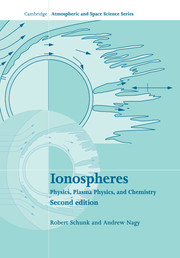Book contents
- Frontmatter
- Contents
- Chapter 1 Introduction
- Chapter 2 Space environment
- Chapter 3 Transport equations
- Chapter 4 Collisions
- Chapter 5 Simplified transport equations
- Chapter 6 Wave phenomena
- Chapter 7 Magnetohydrodynamic formulation
- Chapter 8 Chemical processes
- Chapter 9 Ionization and energy exchange processes
- Chapter 10 Neutral atmospheres
- Chapter 11 The terrestrial ionosphere at middle and low latitudes
- Chapter 12 The terrestrial ionosphere at high latitudes
- Chapter 13 Planetary ionospheres
- Chapter 14 Ionospheric measurement techniques
- Appendix A Physical constants and conversions
- Appendix B Vector relations and operators
- Appendix C Integrals and transformations
- Appendix D Functions and series expansions
- Appendix E Systems of units
- Appendix F Maxwell transfer equations
- Appendix G Collision models
- Appendix H Maxwell velocity distribution
- Appendix I Semilinear expressions for transport coefficients
- Appendix J Solar fluxes and relevant cross sections
- Appendix K Atmospheric models
- Appendix L Scalars, vectors, dyadics, and tensors
- Appendix M Radio wave spectrum
- Appendix N Simple derivation of continuity equation
- Appendix O Numerical solution for F region ionization
- Appendix P Monte Carlo methods
- Index
Chapter 11 - The terrestrial ionosphere at middle and low latitudes
Published online by Cambridge University Press: 22 January 2010
- Frontmatter
- Contents
- Chapter 1 Introduction
- Chapter 2 Space environment
- Chapter 3 Transport equations
- Chapter 4 Collisions
- Chapter 5 Simplified transport equations
- Chapter 6 Wave phenomena
- Chapter 7 Magnetohydrodynamic formulation
- Chapter 8 Chemical processes
- Chapter 9 Ionization and energy exchange processes
- Chapter 10 Neutral atmospheres
- Chapter 11 The terrestrial ionosphere at middle and low latitudes
- Chapter 12 The terrestrial ionosphere at high latitudes
- Chapter 13 Planetary ionospheres
- Chapter 14 Ionospheric measurement techniques
- Appendix A Physical constants and conversions
- Appendix B Vector relations and operators
- Appendix C Integrals and transformations
- Appendix D Functions and series expansions
- Appendix E Systems of units
- Appendix F Maxwell transfer equations
- Appendix G Collision models
- Appendix H Maxwell velocity distribution
- Appendix I Semilinear expressions for transport coefficients
- Appendix J Solar fluxes and relevant cross sections
- Appendix K Atmospheric models
- Appendix L Scalars, vectors, dyadics, and tensors
- Appendix M Radio wave spectrum
- Appendix N Simple derivation of continuity equation
- Appendix O Numerical solution for F region ionization
- Appendix P Monte Carlo methods
- Index
Summary
The plasma parameters in the Earth's ionosphere display a marked variation with altitude, latitude, longitude, universal time, season, solar cycle, and magnetic activity. This variation results not only from the coupling, time delays, and feedback mechanisms that operate in the ionosphere–thermosphere system, but also from the ionosphere's coupling to the other regions in the solar–terrestrial system, including the Sun, the interplanetary medium, the magnetosphere, and the mesosphere. The primary source of plasma and energy for the ionosphere is solar EWV. IV. and X-ray radiation; but magnetospheric electric fields and particle precipitation also have a significant effect on the ionosphere. The strength and form of the magnetospheric effect are primarily determined by the solar wind dynamic pressure and the orientation of the interplanetary magnetic field (IMF), i.e., by the state of the interplanetary medium. Also, tides and gravity waves that propagate up from the mesosphere directly affect the neutral densities in the lower thermosphere, and their variation then affects the plasma densities. The different external driving mechanisms, coupled with the radiative, chemical, dynamical, and electrodynamical processes that operate in the ionosphere, act to determine the global distributions of the plasma densities, temperatures, and drifts.
As noted in Section 2.3, the ionosphere is composed of different regions and, therefore, it is instructive to show the regions in which the different external processes operate. Figure 11.1 indicates the altitudes where the various external processes are most effective. Solar radiation leads to ion–electron production and heating via photoelectron energy degradation, with EUV wavelengths dominating in the lower thermosphere (E and F1 regions) and UV and X-ray wavelengths dominating in the mesosphere (D region). These processes occur over the entire sunlit side of the Earth.
- Type
- Chapter
- Information
- IonospheresPhysics, Plasma Physics, and Chemistry, pp. 335 - 397Publisher: Cambridge University PressPrint publication year: 2009
- 1
- Cited by



